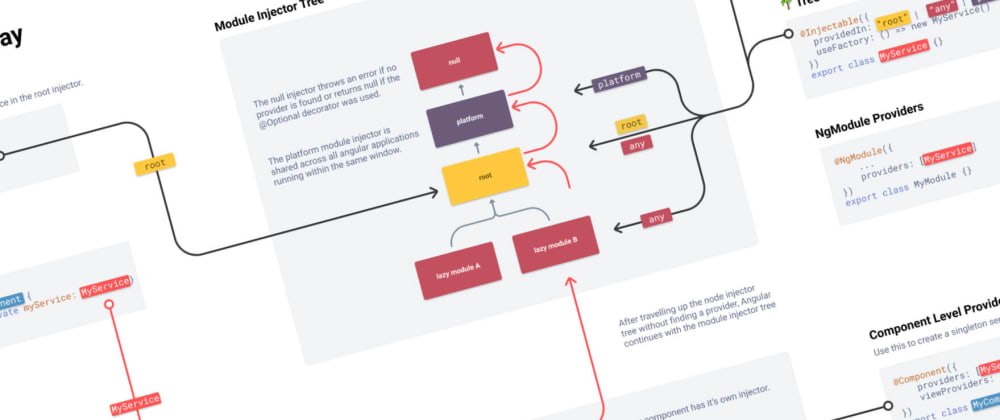The Angular dependency injection is now the core part of the Angular. It allows us to inject dependencies into the Component, Directives, Pipes, or Services. In this tutorial, we will learn what is Angular Dependency Injection is and how to inject dependency into a Component, Directives, Pipes, or a Service by using an example.
What is Dependency
We built an ProductService in the Angular Services tutorial. The AppComponent depends on the ProductService to provide the list of Products to display.
In short, the AppComponent has a dependency on ProductService.
What is Angular Dependency Injection
Dependency Injection (DI) is a technique in which a class receives its dependencies from external sources rather than creating them itself.
Let us look at the ProductService, which we created in our Angular Services tutorial.
Our ProductService returns the hard-coded products when getProduct method invoked.
import {Product} from './Product'
export class ProductService{
public getProducts() {
let products:Product[];
products=[
new Product(1,'Memory Card',500),
new Product(1,'Pen Drive',750),
new Product(1,'Power Bank',100)
]
return products;
}
}If you used ng generate or VSCode “Generate Service”, it will add the following code. Please remove it. We will explain it at the end of the chapter.
@Injectable({ providedIn: ‘root’ })
We instantiated the productService directly in our Component as shown below:
import { Component } from '@angular/core';
import { ProductService } from './product.service';
import { Product } from './product';
@Component({
selector: 'app-root',
templateUrl: './app.component.html',
})
export class AppComponent
{
products:Product[];
productService;
constructor(){
this.productService=new ProductService();
}
getProducts() {
this.products=this.productService.getProducts();
}
}The ProductService Instance is local to the Component. The AppComponent is now tightly coupled to the ProductService, This tight coupling brings a lot of Issues.
The ProductService hardcoded in our AppComponent. What if we want to use BetterProductService. We need to change wherever the ProductService is used and rename it to BetterProductService.
What if ProductService depends on another Service. And then we decide to change the service to some other service. Again we need to search and replace the code manually
It is hard to test this Component as it is difficult to provide the Mock for the ProductService. For Instance, what if we wanted to substitute out the implementation of ProductService with MockProductService during testing.
Our Component Class has now tied one particular implementation of ProductService. It will make it difficult to reuse our components.
We would also like to make our ProductService singleton so that we can use it across our application.
How to solve all these problems. Move the creation of ProductService to the constructor the AppComponent class as shown below:
export class AppComponent {
products:Product[];
constructor(private productService:ProductService) {
}
getProducts() {
this.products=this.productService.getProducts();
}
}Our AppComponent does not create the instance of the ProductService. It just asks for it in its Constructor. The responsibility of Creating the ProductService falls on the creator of the AppComponent.
The above pattern is the Dependency Injection Pattern.
Benefits of Dependency Injection
loosely coupled
Our Component is now loosely coupled to the ProductService.
AppComponent does not know how to create the ProductService. Actually, it does not know anything about the ProductService. It just works with the ProductService passed onto it. You can pass ProductService, BetterProductService or MockProductService. The AppComponent does not care.
Easier to Test
AppComponent is now easier to Test. Our AppComponent is not dependent on a particular implementation of ProductService anymore. It will work with any implementation of ProductService that is passed on to it. You can just create a mockProductService Class and pass it while testing.
Reusing the Component
Reusing of the component is becomes easier. Our Component will now work with any ProductService as long as the interface is honored.
Dependency injection pattern made our AppComponent testable, maintainable, etc.
But does it solve all our Problem ?. No, we just moved the Problem out of Component to the Creator of the Component.
How do we create an instance of ProductService and pass it to the AppComponent? That is what Angular Dependency Injection does.
Angular Dependency Injection Framework
Angular Dependency Injection framework implements the Dependency Injection in Angular. It creates & maintains the Dependencies and injects them into the Components, Directives, or Services.
There are five main players in the Angular Dependency injection Framework.
Consumer
The Consumer is the class (Component, Directive, or Service) that needs the Dependency. In the above example, the AppComponent is the Consumer.
Dependency
The Service that we want to in our consumer. In the above example the ProductService is the Dependency
Injection Token (DI Token)
The Injection Token (DI Token) uniquely identifies a Dependency. We use DI Token when we register dependency
Provider
The Providers Maintain the list of Dependencies along with their Injection Token. It uses the Injection Token is to identify the Dependency.
Injector
Injector holds the Providers and is responsible for resolving the dependencies and injecting the instance of the Dependency to the Consumer.
The Injector uses Injection Token to search for Dependency in the Providers. It then creates an instance of the dependency and injects it into the consumer.
Using Dependency Injection
Registering the Dependency with the Injector
Angular Provides an instance of Injector & Provider to every component & directive in the application ( Consumers). It also creates an Injector instance at the module level and also at the root of the application. Basically, it creates a Tree of Injectors with parent-child relationship.
The dependencies are registered with the Provider. This is done in the Providers metadata of the Injector.
providers: [ProductService]For Example, in the following code ProductService is registered with the Injector of the AppComponent:
@Component({
selector: 'app-root',
templateUrl: './app.component.html',
providers: [ProductService]
})
export class AppComponent
{We can also add the Services to Providers array of the @NgModule. Then they will be available for use in all the components & Services of the application. The ProductService in this case added to the Injector instance at the module level.
@NgModule({
declarations: [...],
imports: [...],
providers: [ProductService],
bootstrap: []
})
Asking for Dependency in the Constructor
The Components, Directives & Services (Consumers) declare the dependencies that they need in their constructor.
constructor(private productService:ProductService) {
}Injector reads the dependencies from the constructor of the Consumer. It then looks for that dependency in the provider. The Provider provides the instance and injector, then injects it into the consumer.
If the instance of the Dependency already exists, then it will reuse it. This will make the dependency singleton.
Angular Dependency Injection Example
We had created a simple ProductService in our last tutorial. Let us now update it to use Dependency Injection.
First, we need to register the dependencies with the provider. This is done in the providers metadata array of @Component decorator.
providers: [ProductService]Next, we need to tell angular that our component needs dependency injection. This is done by using the @Injectable() decorator.
@Injectable() decorator is not needed if the class already has other Angular decorators like @Component, @pipe or @directive etc. Because all these are a subtype of Injectable.
Since our AppComponent is already decorated with @Component, we do not need to decorate with the @Injectable
Next, our AppComponent needs to ask for the dependencies. We do that in the constructor of the Component.
constructor(private productService:ProductService) {
}That’s it.
When AppComponent is instantiated it gets its own Injector instance. The Injector knows that AppComponent requires ProductService by looking at its constructor. It then looks at the Providers for a match and Provides an instance of ProductService to the AppComponent
The Complete AppComponent is as follows.
import { Component } from '@angular/core';
import { ProductService } from './product.service';
import { Product } from './product';
@Component({
selector: 'app-root',
templateUrl: './app.component.html',
providers: [ProductService]
})
export class AppComponent
{
products:Product[];
constructor(private productService:ProductService){
}
getProducts() {
this.products=this.productService.getProducts();
}
}Injecting Service into Another Service
We looked at how to inject ProductService to a component. Now let us look at how to inject service into another service.
Let us build loggerService, which logs every operation into a console window and inject it into our ProductService.
Logger Service
Create the logger.service.ts and add the following code:
import { Injectable } from '@angular/core';
@Injectable()
export class LoggerService {
log(message:any) {
console.log(message);
}
}The LoggerService has just one method log, which takes a message and writes it to the console.
We are also using @Injectable metadata to decorate our logger class. Technically, we do not have to do that as the logger service does not have any external dependencies.
We do not have to use the @Injectable if the class does not have any dependencies.
However, it is best practice is to decorate every service class with @Injectable(), even those that don’t have dependencies for the following reasons
Future proofing: No need to remember @Injectable() when we add a dependency later.
Consistency: All services follow the same rules, and we don’t have to wonder why a decorator is missing.
Product Service
Now we want to inject this into our ProductService class.
The ProductService needs loggerService to be injected. Hence the class requires @Injectable metadata.
@Injectable()
export class ProductService{}Next, In the constructor of the ProductService ask for the loggerService.
constructor(private loggerService: LoggerService) {
this.loggerService.log("Product Service Constructed");
}And update the GetProducts method to use the Logger Service.
public getProducts() {
this.loggerService.log("getProducts called");
let products:Product[];
products=[
new Product(1,'Memory Card',500),
new Product(1,'Pen Drive',750),
new Product(1,'Power Bank',100)
]
this.loggerService.log(products);
return products;
}Finally, we need to register LoggerService with the Providers metadata.
Angular does not have any options add providers in the Service Class. The Providers must be added to the Component, Directive, or in the Module.
Open the AppComponent update the providers array to include LoggerService.
providers: [ProductService,LoggerService]That’s it. As you click on the Get Products button, you will see the Console window updated with the Log messages.
Providing Dependency from Angular Module
In the above example, we registered the dependencies in the Providers array of the component class. The dependencies are only available to the component where we register them and to its child components.
To Make the dependencies available to the entire application, we need to register it in the root module.
Remove the providers: [ProductService,LoggerService], from the AppComponent and move it to the AppModule as shown below
import { BrowserModule } from '@angular/platform-browser';
import { NgModule } from '@angular/core';
import { HttpModule } from '@angular/http';
import { FormsModule } from '@angular/forms';
import { AppComponent } from './app.component';
import { ProductService } from './product.service';
import { LoggerService } from './logger.service';
@NgModule({
declarations: [
AppComponent
],
imports: [
BrowserModule,
HttpModule,
FormsModule
],
providers: [ProductService,LoggerService],
bootstrap: [AppComponent]
})
export class AppModule { }Providing the service in the root module will create a single, shared instance of service and injects into any class that asks for it.
The above code works because Angular creates the Tree of Injectors with parent-child relationship similar to the Component Tree.
ProvidedIn
Instead of adding ProductService to providers of the AppModule, you can also add it in the providedIn metadata with the value root.
In fact, using the ProvidedIn is the preferred way to provide a service in a module.
@Injectable({
providedIn:'root'
})
export class ProductService {@Injectable({
providedIn:'root'
})
export class LoggerService {Service Scope
The services that we provide at the root module are app-scoped, which means that we can access them from every component/service within the app.
Any service provided in the other Modules (Other than the Lazy Loaded Module) is also available for the entire application.
The services that are provided in a Lazy Loaded Module are module scoped and available only in the Lazy loaded module.
The services provided at the Component level are available only to the Component & and to the child components.





 Javascript Promise tutorial
Javascript Promise tutorial